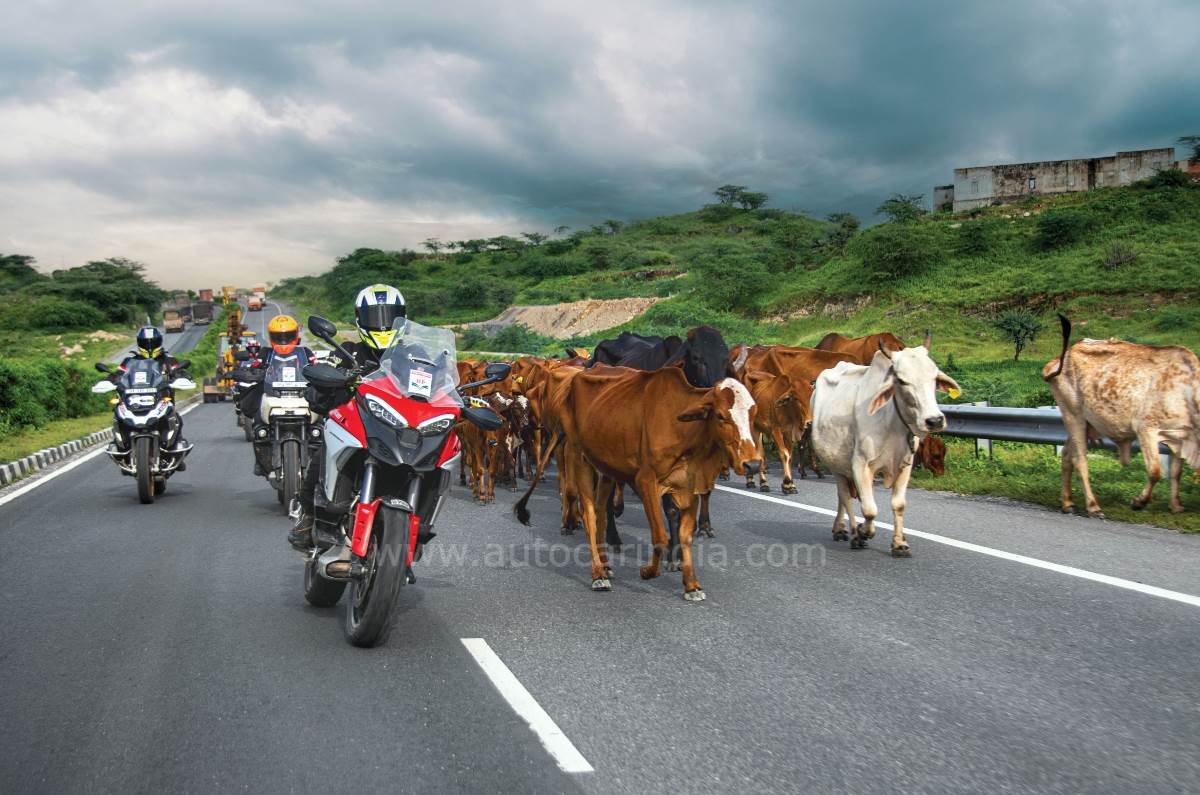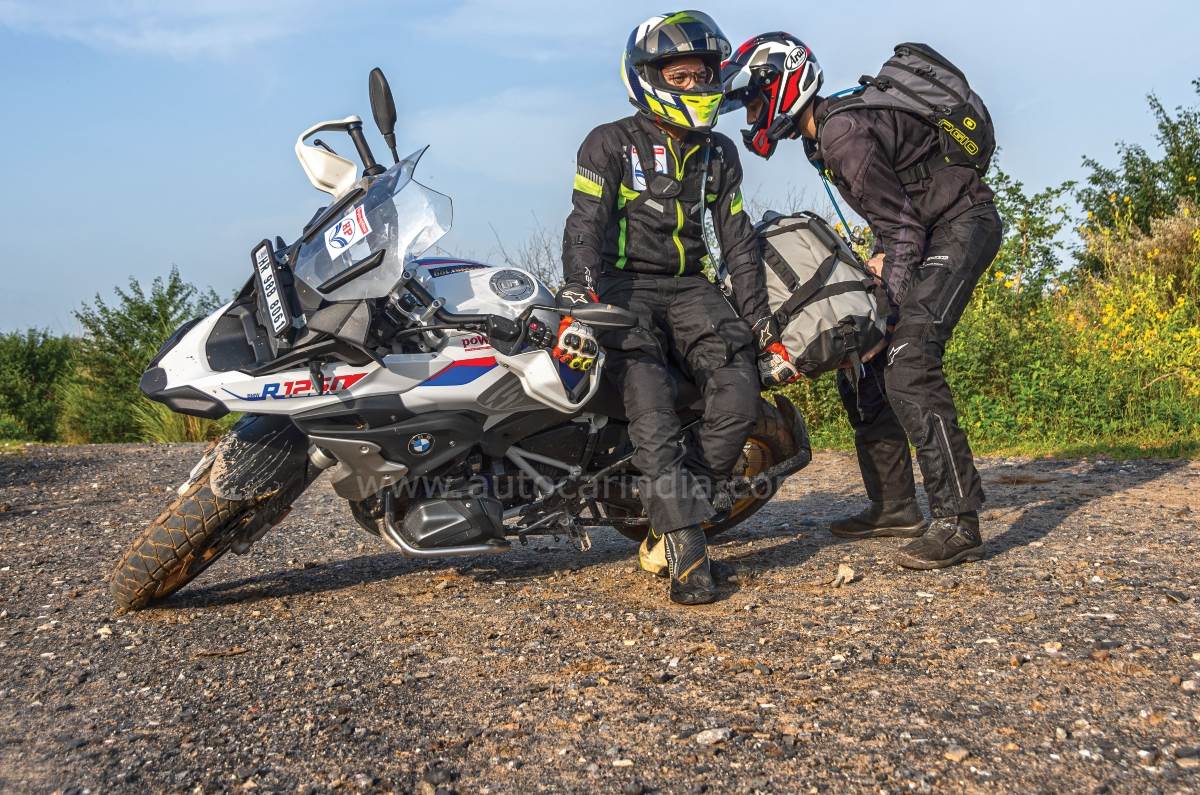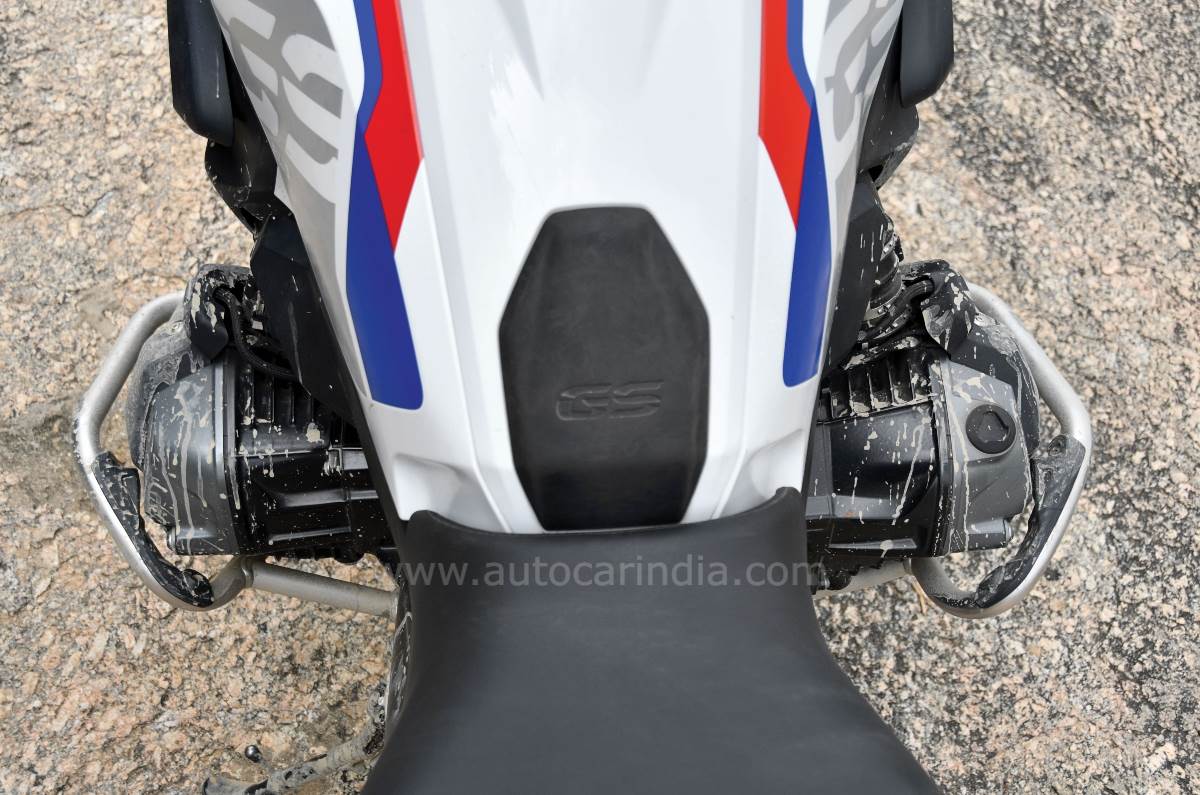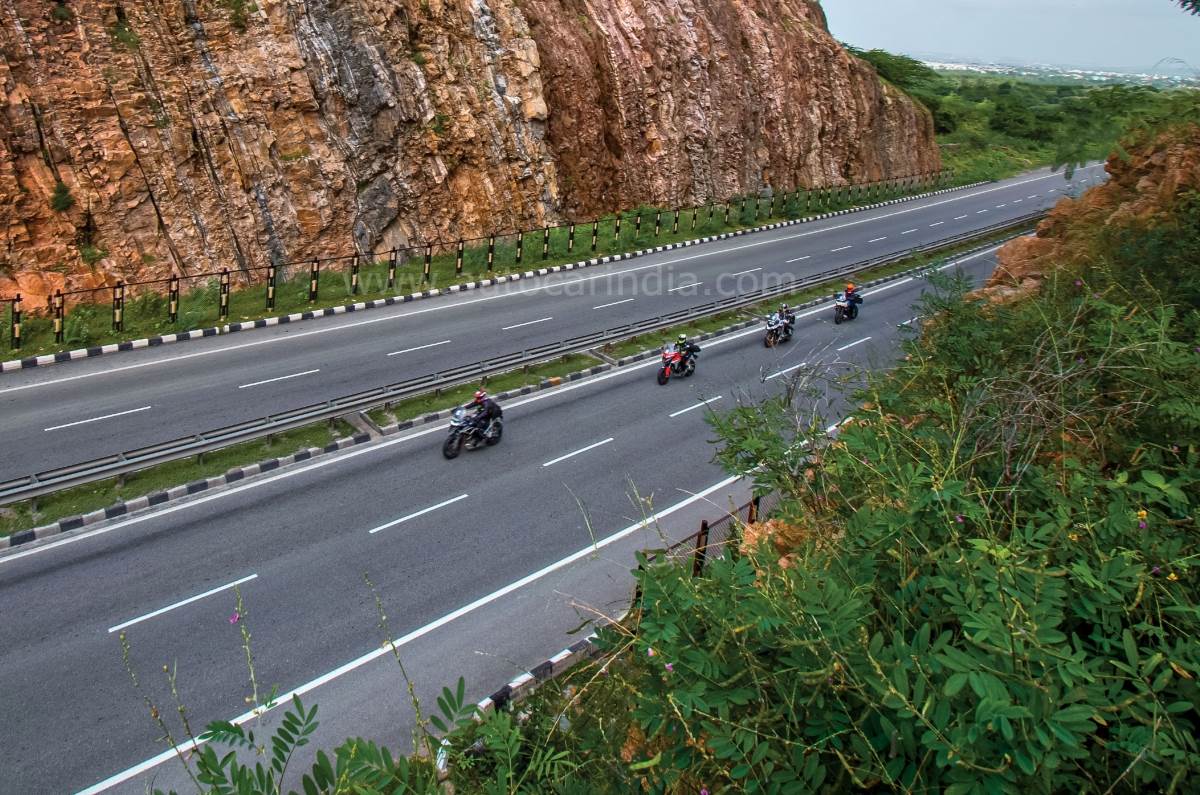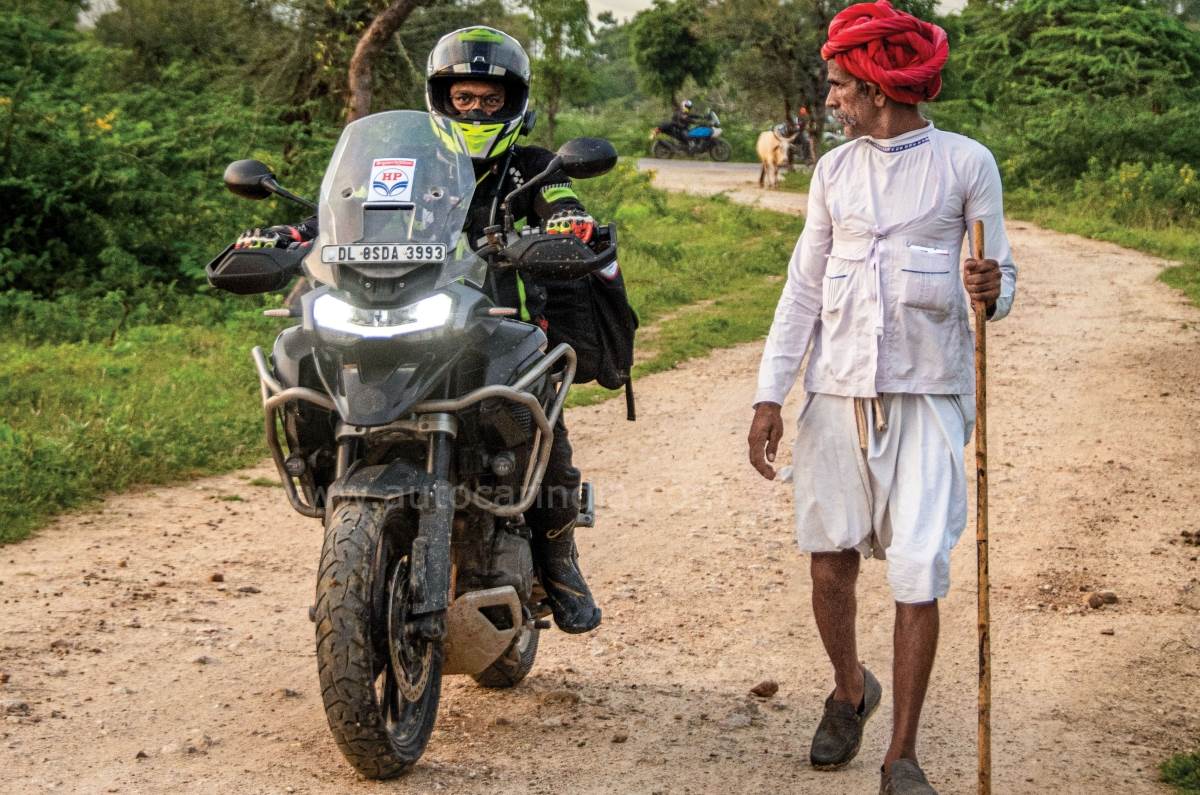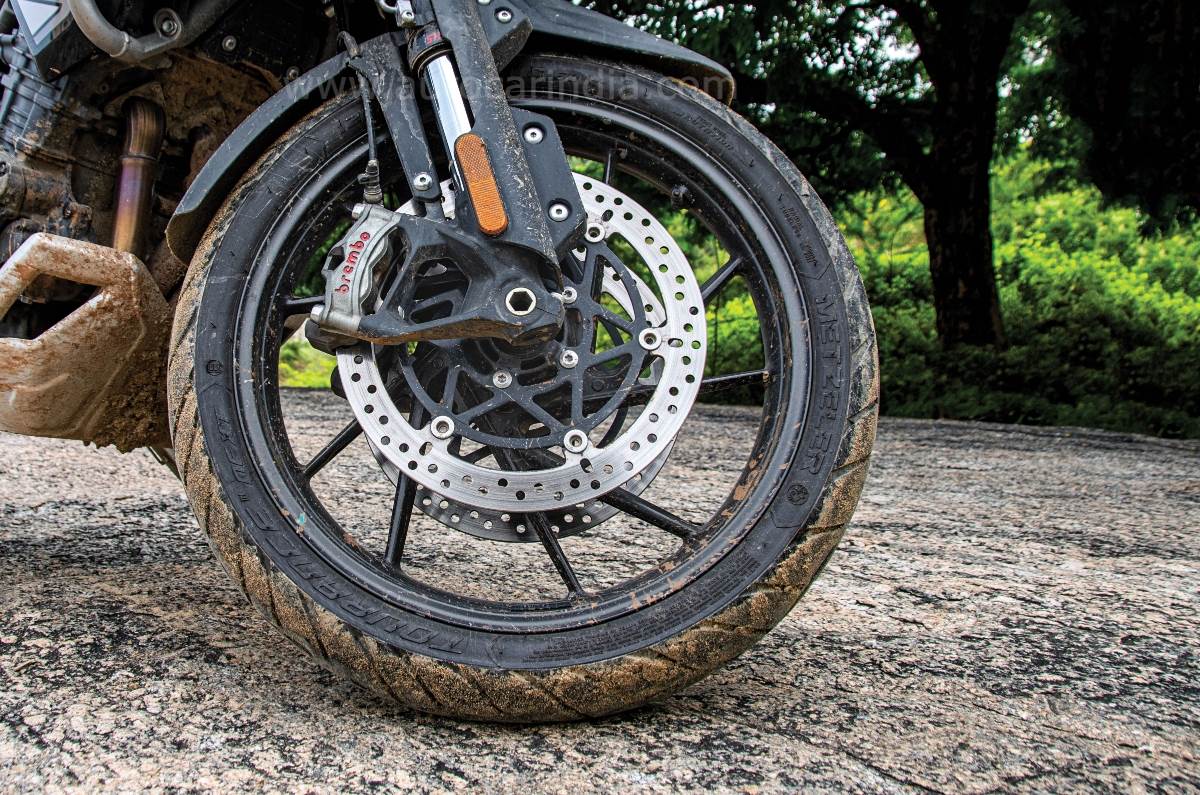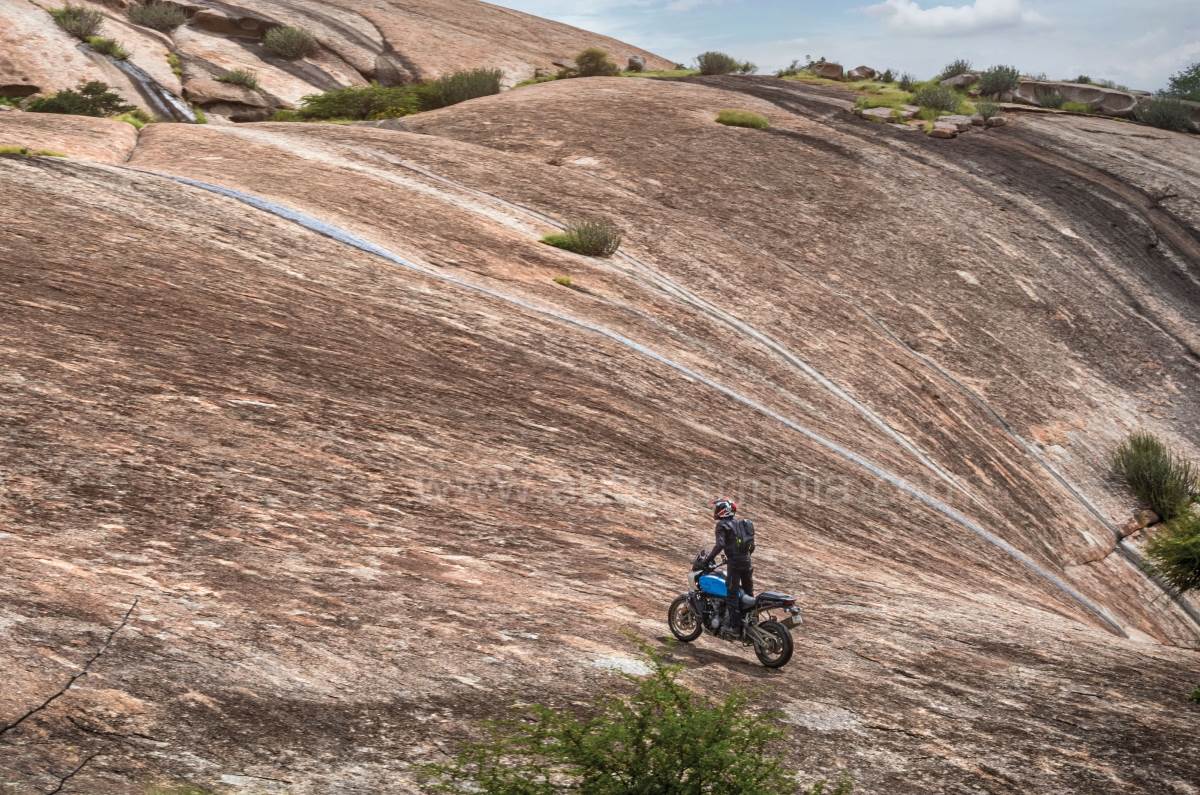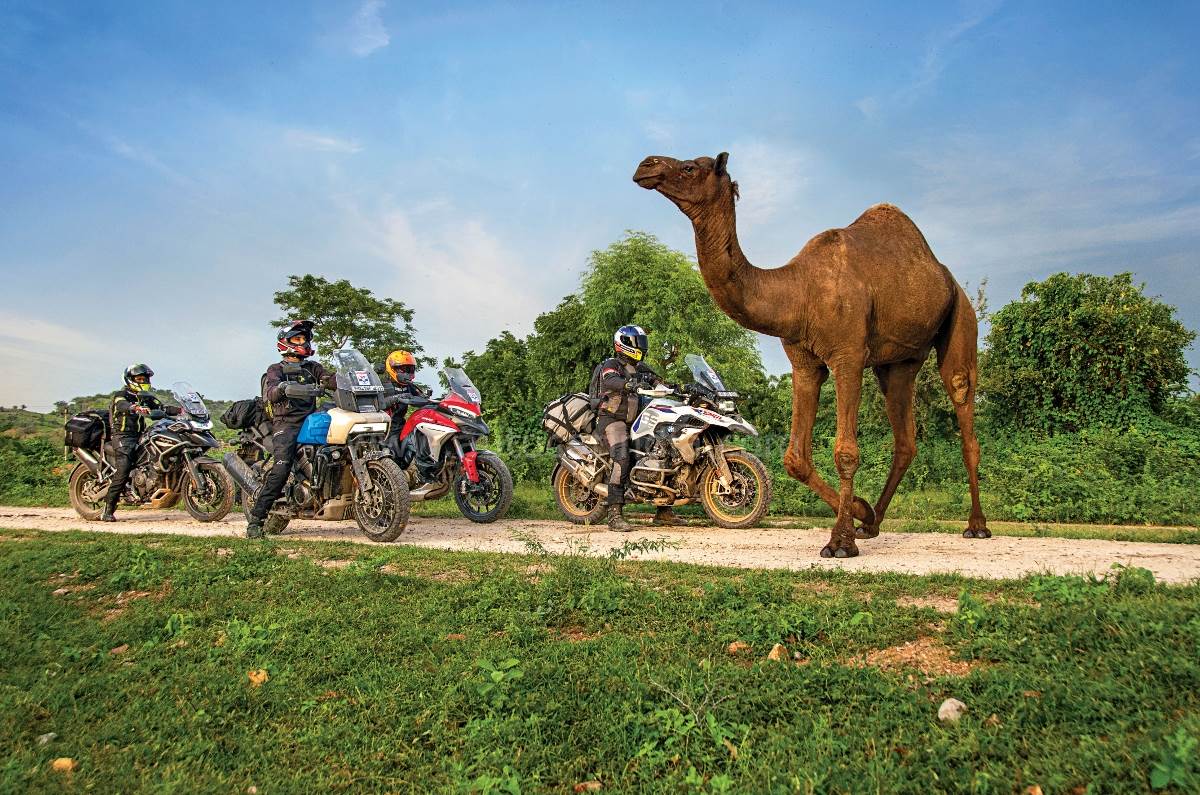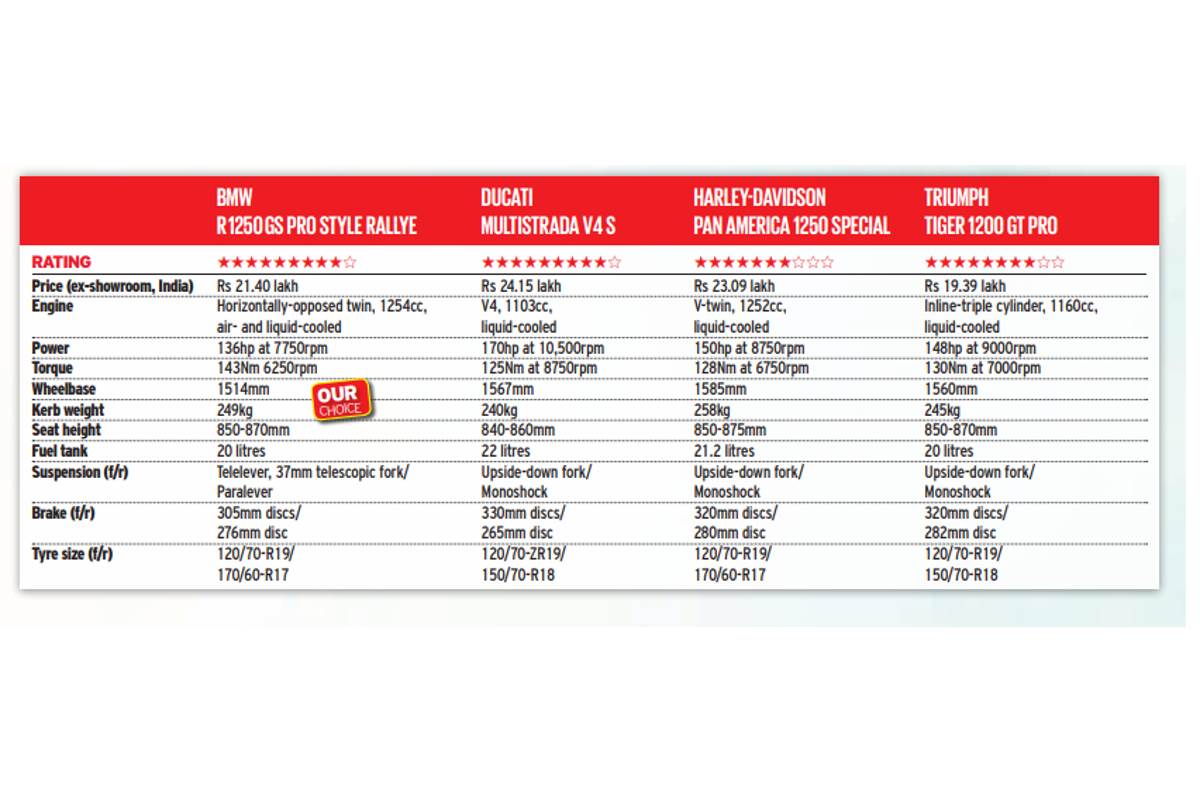Four of the most complete go-anywhere motorcycles on the planet today. A 2,000km journey with over 600hp on tap. We find out which flagship adventure tourer emerges on top.
The job of a motoring journalist is often perceived as rather glamorous and enjoyable, because from the outside, it probably is. But our profession also comes with more than its fair share of challenges. We frequently have just a few hours and a few score kilometres to evaluate a vehicle that someone is going to buy with money they’ve saved up over many months, perhaps years. There’s a lot of condensed and concentrated learning and analysis involved, which only truly gets enabled by years of experience. But, of course, the more time and distance you spend on a motorcycle, the better you get to know it, and the clearer your opinion becomes.
Wondering what the royal ladies of the Hawa Mahal would have made of our 4 bikes prowling through the streets of ancient Jaipur.
Which is why when it came time to compare the four motorcycles you see here, a few hours and a few hundred kilometres simply weren’t going to cut it. These bikes aren’t just apex predators in their own field, but also some of the most complete go-anywhere machines on the planet today. So they got the evaluation they deserved – a 2,000km journey from Delhi to Mumbai. And we took the scenic route, giving these bikes the chance to devour some twisties and venture off-road, too.
IN THE RED CORNER
The tall red one that’s probably grabbing your attention right now is the Ducati Multistrada V4. In a way that only Ducati can, the Italian manufacturer has taken the V4 engine from its all-conquering superbike, the Panigale V4, and tweaked it so that it’s less racetrack-scorcher and more mile-muncher. Which is why the big Multi is comfortably the most powerful motorcycle here, with a 170hp figure that wouldn’t seem out of place on a super-naked.
The bike least likely to need an introduction here is the BMW R 1250 GS, but here’s one anyway. The modern-day iteration of the motorcycle that created the adventure bike, the 1980 BMW R 80 G/S, the Bavarian giant has had close to half a century to perfect the formula. But the fundamentals remain the same. Like the original, it uses a boxer-twin engine, and is designed to be equally capable on- and off-road (the G is for Gelände, ‘off-road’ in German; S is for Straße, or ‘street’).
Nothing falls like a big GS – boxer engine, crash guards and foot pegs keep the rest of the bike well protected. It’s also the easiest to pick up.
The Triumph Tiger isn’t a motorcycle lacking in heritage either. It’s been around as a nametag since 1937 and as a line-up of adventure bikes since 1993. The range-topping Tiger 1200 recently underwent a radical overhaul, with an all-new engine and chassis concept that Triumph has openly stated is targeted squarely at the GS. Like the Beemer, it’s got a shaft-drive system (the other two bikes here get more maintenance-hungry chain-drive systems), and the Brit bike maker has even tried to make its signature inline-triple-cylinder engine mimic the behaviour of a twin, with an innovative T-plane crankshaft.
The final boxer in this ring is perhaps the most curious. More like a rodeo bull rider that decided to wander into a boxing ring, really. The Harley-Davidson Pan America 1250 marks arguably the biggest departure from the norm in the 119-year history of the Milwaukee cruiser specialist. Its first crack at the adventure bike segment, the debutant enters an arena that’s got heavyweights throwing deadly hooks and stinging jabs. Saying that it has its work cut out is an understatement almost as large as the bike itself.
BULL IN A CHINA SHOP?
With my 5’8” frame and lanky build, these flagship ADVs are perhaps the most intimidating segment of them all to me – they have tall seats and their weights are over four times greater than my own. But the Multi is the most inviting of the lot, on paper at least. You can drop its seat down to 840mm – not low in absolute terms, but still the lowest here. At 240kg, it’s also the lightest.
But the Duc’s friendly nature goes beyond the numbers. This V4 achieves a level of usability in the bottom range of the tachometer that previous Multis could never dream of, even with their variable valve timing systems. The first touch of the throttle is surprisingly soft for a 170hp machine, even in Sport mode, but there’s enough grunt at the bottom to comfortably haul you around the city without really needing to work the motor. For most of the traffic-riddled stint through Delhi and Gurugram, I barely went past 3,000rpm, and the V4 Granturismo engine dutifully went about its job, throwing in a deliciously snarly (but not unruly) soundtrack to boot.
Soon after breaking the shackles of traffic, I got my first taste of what so many have been raving about for so long. As capable as the Multi’s engine is at low RPM, the latter half of the tachometer is where it really comes alive. And as soon as I got the chance, I took it there. It was only a few hard pulls, and none of them went close to the 10,500rpm mark where the engine makes its peak 170hp. But the acceleration already felt ferocious, and the gauntlet was well and truly laid down. The Multi had loads left in reserve, of course, but I wouldn’t find out until later. Soon after, we stopped for a bite and swapped bikes.
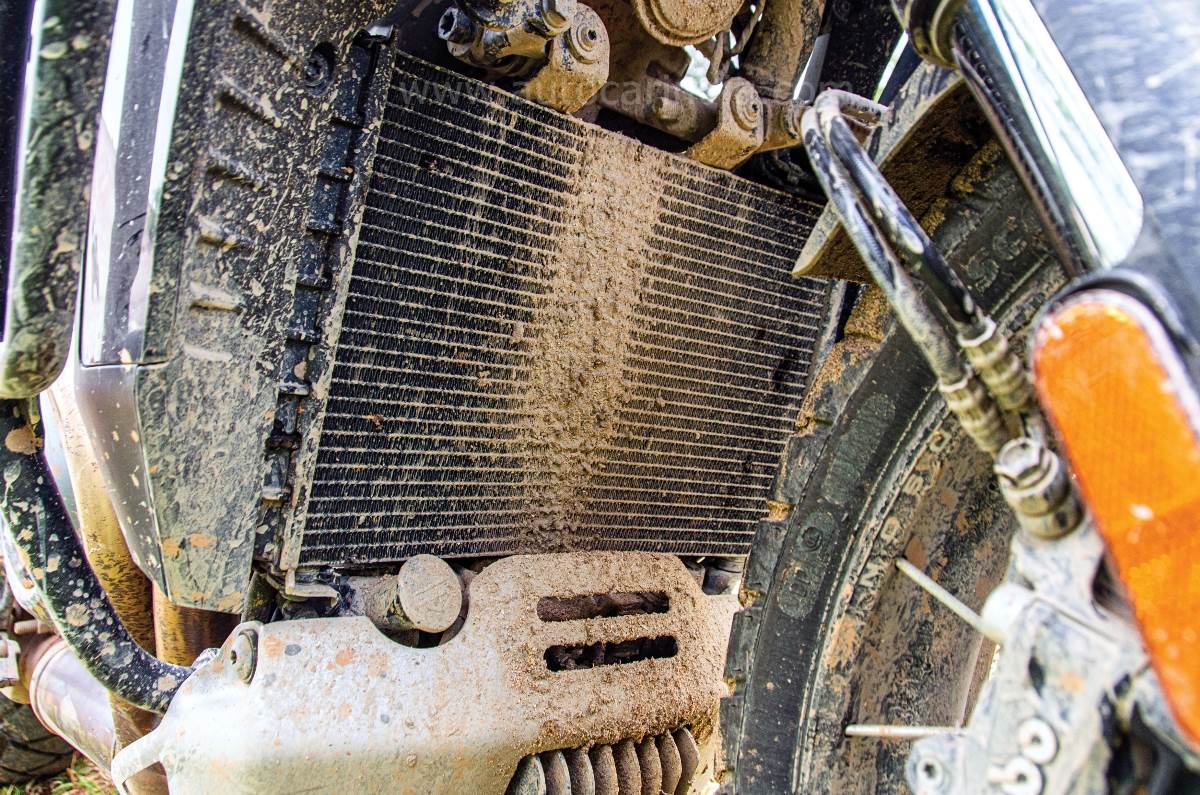
Harley’s central radiator clogs easily, throws a lot of heat onto rider.
So, for much of the highway stint to Jaipur, I ended up aboard the Pan Am – a bike that constantly reminds you that it’s a Harley-Davidson, and yet, completely breaks the mould for what a Harley should be. In this company, it certainly feels like the largest, longest, heaviest motorcycle. Because it is. Slicing through highway traffic, the same manoeuvres that seemed telepathic on the Ducati required considerably more effort on the big H-D. But it also feels like the second quickest bike here, and for a company that’s historically abstained from even revealing power figures for most of its motorcycles, this is a pleasant surprise. The liquid-cooled Revolution Max motor doesn’t have the top-end of the Multi, nor the tractability of the GS, but there’s a nice, even spread of grunt across the rev-range, and it certainly hauls when you need it to.
Capability definitely isn’t lacking, but this motor does struggle to match the charm of the other engines here – all four powerplants have mild vibrations at different points, but, while on the other bikes they seem to add to the feel and character of the motorcycle, the Pan Am’s engine comes across as a little more thrummy and gruff. Overall, it just doesn’t feel quite as polished, and that feeling is reinforced by things like the absence of a quickshifter and the presence of a centrally mounted radiator (all others here get split radiators), which throws a tremendous amount of heat onto the rider, especially after it gets clogged off-road.
Beemer’s boxer twin looks and feels special.
Charm and character are something the GS has in spades; you feel this within seconds of jumping aboard. Simple acts like thumbing the starter – the way the boxer engine comes to life with a little bark every time and lightly rocks the bike from side-to-side – really set the tone for what is a rather special experience every time you ride this motorcycle. There’s a tremendous sense of occasion with the GS, even more so than with the Ducati, and that’s not something you usually expect or receive from BMW.
This engine goes about its business completely unlike the Ducati. Where the Multi makes the most power and the least torque of this bunch, the Beemer is inverted. It’s the least powerful, but serves up dollops of torque right from the get-go. The end result is an air of effortlessness that you really appreciate on this genre of motorcycle. It certainly isn’t the quickest motorcycle here, but all four bikes are ludicrously quick upto the 140-150kph mark, and it’s only beyond that, that the performance differences become stark. What you’re more likely to feel in the real world is that the Beemer has the strongest low-RPM performance, the lightest clutch, throttle response that feels just right, and you don’t need to use lots of revs to get a move on.
But the effortlessness extends beyond just the engine. The GS is just about the most perfectly balanced motorcycle I’ve ever had the pleasure of riding. Weight distribution feels absolutely spot-on – the boxer engine format concentrates the mass low-down in the belly. of the bike – and the unique Telelever front suspension is nothing short of witchcraft, delivering a steering feel so light, you forget that this is actually the second-heaviest bike here.
The following day, I jumped aboard the Tiger 1200 for the first time, and was greeted by a rather non-conformist inline-triple motor. Where most other Triumph triples are rather peaky and only reward you when you pile on the revs, the T-plane crank on this Tiger means the concentration of grunt has slidden down to more accessible regions of the rev range (sounds rather GS-like, doesn’t it?). It’s certainly a more real-world usable configuration, even if it can’t quite match the top-end of the Duc or Harley.
ALL ABOARD THE MAGIC CARPET
What also surprises you on the Tiger is just how plush the ride quality is. Once again, you can tell it’s got the Beemer in its crosshairs, but in this department, it outdoes even the GS. The BMW offers quite a soft and pillow-y ride, and feels borderline underdamped. But sharp edges filter through, and the Tiger does a better job of rounding them off, and maintaining body control. All bikes here feature immensely impressive electronically-controlled semi-active suspension, but it’s the Triumph’s set-up that does the best job of keeping you isolated from what’s underneath.
Some say these bikes are overkill for Indian roads. Rajasthan’s spectacular highways beg to differ.
The Multistrada sits at the opposite end of the spectrum. In isolation, it offers a fairly comfortable ride, especially considering its performance levels. But in this company, it’s got the least suspension travel (170mm/180mm), and has noticeably the firmest set-up here. It sends the most road imperfections to your backside, and even towards the softer end of its adjustability, the ride was undeniably the sportiest of the lot.
The Pan America once again preaches moderation – its ride isn’t quite as plush as the Tiger and GS, but it isn’t as uncomfortable as the Ducati either, and overall, it does a decent job of flattening out the road. The trick up its sleeve is the Adaptive Ride Height (ARH) feature, which lowers the electronic monoshock by 1-2 inches when you come to a stop, allowing shorter riders to more easily get their feet down.
IN THE LAP OF THE GODS
For bikes that are meant to live on the open road, comfortable seating is a must, and no bike falls short in this regard. But some shine brighter than others. You can tell that the Pan Am is Harley’s first crack at this segment, because its rider’s triangle isn’t quite spot-on – the forward reach to the handlebars is a little longer than I’d like, which strains your arms and lower back, and the foot pegs feel the most rear-set, so the bend in your knees is most severe. Once again, as a standalone motorcycle, the Harley’s seating is reasonably comfortable, but it’s just outclassed in this company.
Sometimes you’re the looker, sometimes you’re the lookee.
The Tiger does a better job on most fronts, and it feels like it’s got the lowest foot pegs of the bunch, so your legs are nice and relaxed. But one quirk here is a strange outward/upward kink at the ends of the handlebars that places your arms in a naturally elbows-out position. It’s something that you get used to after a while, but it does accelerate the fatigue in your arms over longer stretches.
What strikes you on the Multistrada is the very strong feeling of sitting ‘in’ the motorcycle rather than on it – the seat feels quite scooped-out and the cockpit seems to rise up all around you. The seat itself is actually one of the most supportive of the lot. It’s quite wide, and I found it rather roomy, but taller riders will rue a lack of length, leaving little room to scoot forwards and backwards. On the whole, you’re still quite comfortable, though – the handlebar is wide, you’ve got loads of steering lock, and though the foot pegs are placed on the sportier side, it’s only very tall riders who will find them a little cramped.
A large chunk of BMW’s 40 years perfecting the GS must’ve been devoted to seating comfort, because the riding position feels absolutely dead-on. The handlebars fall perfectly to hand, the foot pegs are in just the right place, and all of it feels just as appropriate when you’re standing up and riding off-road. If there is one drawback here, it’s that the seat cushioning is a little too soft, and you do sink in after a while.
THE LONG WAY ROUND
After two days blasting across Rajasthan’s fabulous highways, day 3 finally gave us the opportunity to attack some twisties. We managed to find either poWer99 or poWer100 high-octane fuel (all these bikes prefer good fuel, and the Ducati absolutely needs it) all through the trip, even in a relatively smaller town like Jodhpur, and on the long sweepers leading out of the town, it should come as no surprise that the Ducati was the most taut-feeling, sharp-handling bike here. But what you might not expect, is that the GS is very nearly as capable in the corners, with the light handling and planted feel making for a very low-effort yet confidence-inspiring motorcycle, even if it doesn’t feel quite as sporty and connected as the Multi.
Tiger’s Stylemas are the best brakes here.
The Triumph is quite a natural and predictable handler on its own, and holds a line well once leaned over. But go too far and those low-set foot pegs begin to graze against the tarmac. You do also feel that it requires a little more handlebar effort than the other Europeans. But it’s really the Harley that feels the most cumbersome of the lot; relatively speaking. It’s 9kg heavier than the next bike here, with a wheelbase that’s almost 20mm longer. So there is a logical explanation as to why this bike requires the most effort to lean over, and can’t hold quite as tight a line as the others. But once again, considering its heft, it does a tidy job; and by historical Harley standards, this is a sweet-handling motorcycle if you’re willing to put some work into it.
As for the brakes, there’s very little room for complaint across the board, and all bikes stop rather well. But the Harley and GS need the most physical input from the rider, the Multistrada stops very well, and the Tiger has the sharpest, most impressive brakes here.
OFF THE BEATEN PATH
By the end of day 3, each bike had established a strong and unique identity on the road, and day 4 gave us the opportunity to find out how much got carried over off-road. And unsurprisingly, it was quite a lot.
True to the design brief, the GS is just as effortless and capable off-road as it is on it. The sublime balance, light controls and easily accessible torque completely flatter your abilities, allowing you to do things you feel really shouldn’t be possible on a bike this heavy. It’s extremely manageable during technical low-speed manoeuvring, and still has the composure and suspension travel for when the pace gets hotter.
The pleasant surprise off-road is the Multistrada. With all that focus on performance and sportiness, you’d think there’d be a trade-off off-road, as has been with its predecessors. And while it still feels the most road-biased here in terms of ergos, it is now a surprisingly handy motorcycle off the tarmac, with a great deal more competence than before. The motor is far more flexible than previous Multis, and the suspension makes good use of its relatively limited travel (170mm/180mm) to make sure the bike can handle the rough stuff rather well. More than anything else, you wouldn’t think twice before taking it off-road, which certainly wasn’t the case with the earlier models with their 17-inch front rim.
Pan Am very capable, but requires more effort off-road than the others.
As for the Harley, it once again feels the biggest here and needs the most work, but the bike has quite a lot of capability and can really take a beating. This Special variant of the Pan Am is the only bike here with crash bars as standard and this is something you’d definitely want to option as an extra on the other three. We, err, ‘tested’ the bars on the GS and Tiger a couple of times and they kept the bikes completely free from harm.
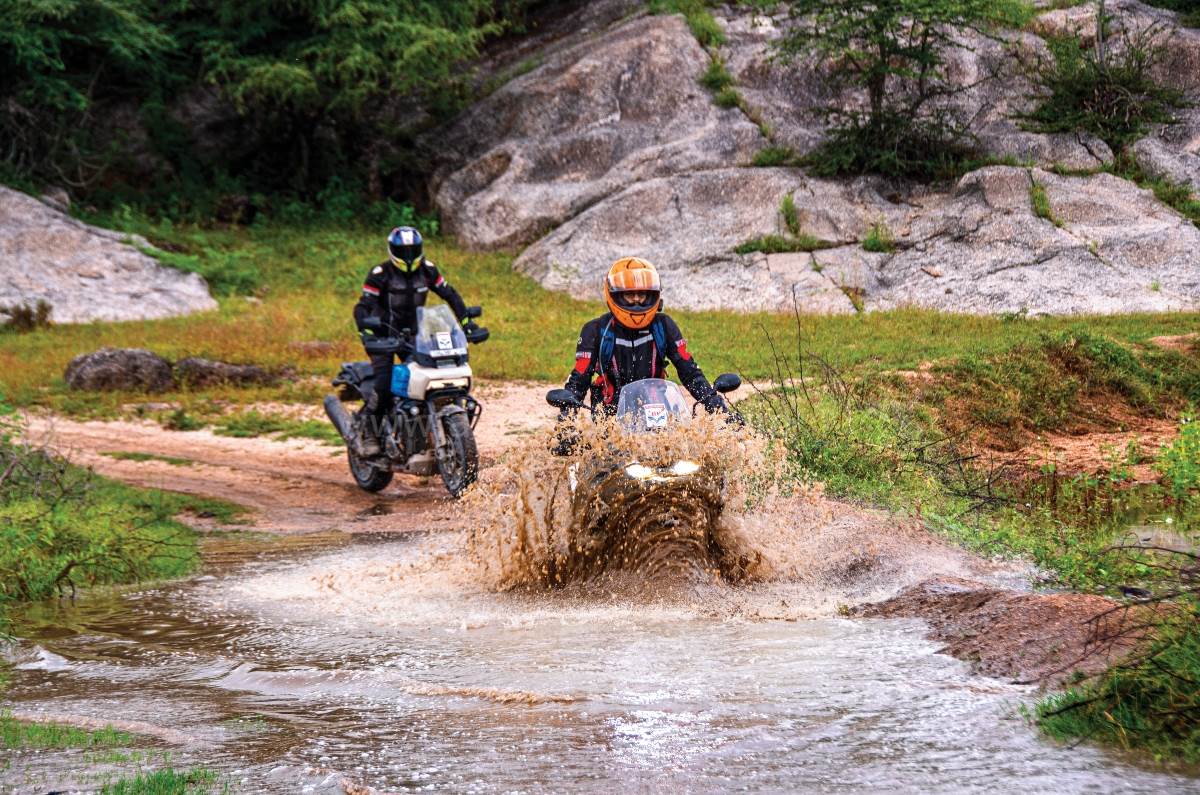
A Tiger makes a splash in a forest,and a Harley is around to hear it.
As it does on the road, the Tiger doesn’t feel quite as easy as the GS off-road, but it has all the right ingredients: a strong bottom-end, pleasant ergos and the most suspension travel here (200mm at both ends). With more off-road focused set of tyres, even this GT version will be quite capable off-road, but it did have a tendency to stall unexpectedly, and that certainly robs you of confidence. What’s also troublesome is that the bike isn’t always very willing to restart quickly after a stall.
FEATURE FRENZY
By the final day of our ride, most of the shooting was completed, meaning we could turn our attention to the raft of features that these motorcycles come with. Spartan is the last word that springs to mind – the list of standard equipment across all bikes includes cruise control, electronic suspension, a varying number of riding modes and rider aids, all enhanced by IMUs, TFT displays with Bluetooth connectivity, and cornering lights.
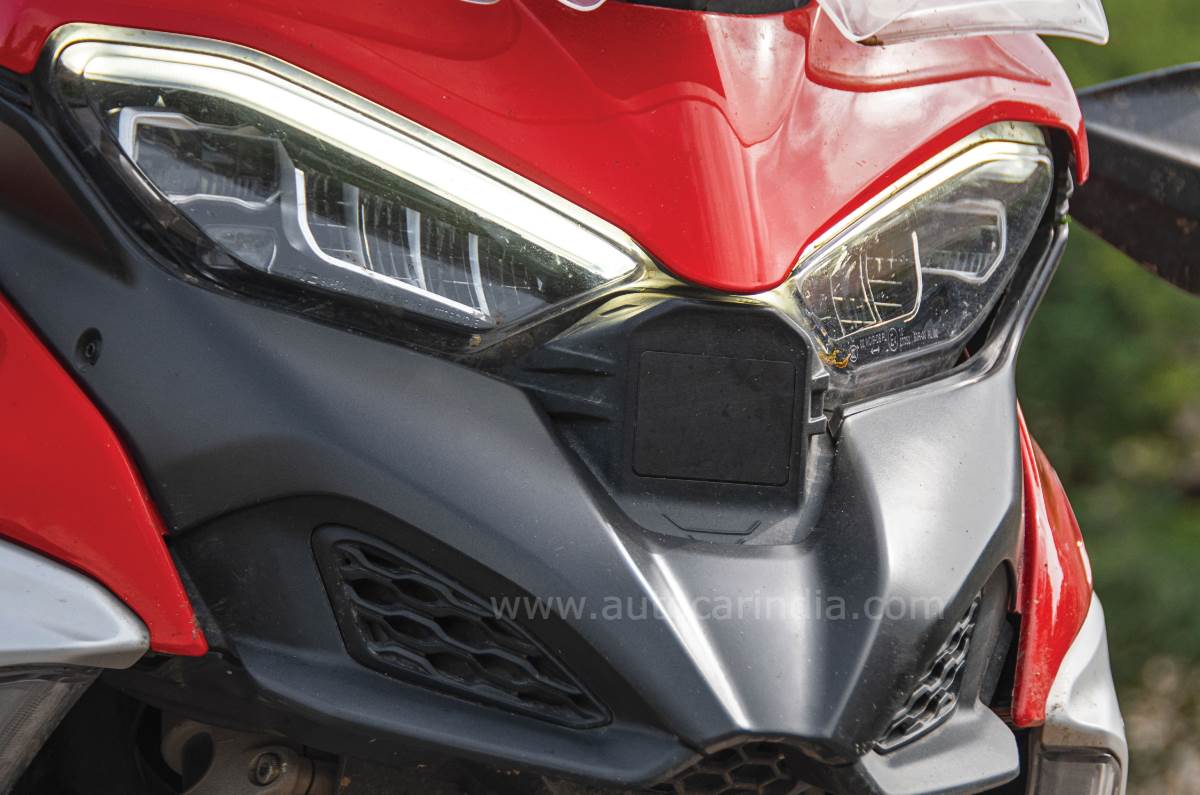
Duc’s radar systems not suited to our roads.
But there are some noteworthy presences and absences. The Harley is the only bike to miss out on hill-hold and a quickshifter, but the only one to get the clever adaptive ride height system. The Multistrada’s radar-assisted Adaptive Cruise Control and Blind Spot Detection systems (a global two-wheeler debut for this technology) are exclusive in this group, but it forgoes heated grips as standard. The only noteworthy miss on the Tiger is a steering damper. But the bigger issue is its TFT display, which is loaded with functionality, but is very slow to start-up and has rather stuttery animations; this stops it from feeling slick. The GS has no ace up its sleeve in terms of features, but no glaring omissions either, and it’s got pretty much everything you could ever want on a motorcycle. Adaptive cruise control on a future update would certainly help boost its already excellent touring abilities, though.

Tiger’s screen very functional, animations not smooth.
Part of the reason why these bikes can munch miles so well is because they keep you well isolated from windblast. It’s the Harley that offers the most protection here, but on hot days, it can almost become too stuffy, and its screen adjustment mechanism is also the most cumbersome here. It’s the Multi and the Tiger that have the most convenient systems, but the Ducati’s mechanism has a lot of opaque black plastic which blocks your view, and the Triumph’s arrangement is prone to getting clogged by gunk after a while. The Beemer’s adjustment mechanism isn’t the most easy to use, but the rotary-wheel design does allow you to fine tune the screen’s placement, and the GS allows just the right amount of ventilation through, while still keeping you well shielded from the brunt of it.
JOINT (AD)VENTURE
It goes without saying that all of these are extremely well-sorted motorcycles. There are certainly no fatal flaws here, and the differences between them are more about character and identity than a stark variation in capability. And yet, despite the closeness and intensity of competition, there is one bike that stands out as the undisputed best.
It’s not everyday that Rishaad has to turn his head up to look at someone.
The Pan America is a truly commendable first attempt by Harley-Davidson at an adventure bike, and we were thoroughly impressed with it when we rode it in isolation last year. The trouble here is that Harley chose this adventure tourer segment for its breakaway because this is where the action is, in terms of sales and popularity. Unfortunately, that also means there is some fierce competition here, with a number of manufacturers that have decades of experience to fall back on. All that know-how counts for something, and this company brings out a few chinks in the Pan Am’s armour. It’s also a little too expensive for its own good, and this colour option with wire-spoke wheels and ARH will cost you Rs 23.09 lakh.
The Tiger has a lot going for it, and in many ways, it’s the best value-for-money package here. This GT version comes in just one fully loaded Pro variant, which, at Rs 19.39 lakh (for this colour), is comfortably the most affordable here, despite managing to play in the same performance ballpark and offering almost all the same features. But there are some niggles that take away from the overall experience (things like the TFT screen’s shortcomings and the engine stalling/restarting issue), which means it isn’t quite as polished and effortless as the Beemer or the Ducati. It’s also worth mentioning that the Tiger 1200 Rally Pro, with its 21-inch front wheel and extra suspension travel, is easily the most off-road capable big ADV in India, if you’re into that sort of thing.
Maybe he wouldn’t be trying these stunts if he knew a crocodile was just a few feet away in the water.
The Multistrada V4 is a truly remarkable motorcycle, in that it allows you to enjoy ludicrous levels of performance in exceptional levels of comfort. It also packs in some class-leading technology, and is considerably more capable than its predecessors. In many ways, it’s the segment leader. But as great as this bike is for joyrides, and as appealing as its sporty demeanour will be to enthusiastic riders, it doesn’t necessarily make for the best adventure tourer, especially when you consider that it has the biggest appetite for fuel here. At Rs 24.15 lakh in its most affordable form, the lightest bike here also lightens your wallet the most (though you could argue that the extra performance and the radar systems justify some of it – but the latter feels a bit too sensitive for our chaos).
And so, experience is the best teacher, it turns out. The company that birthed the adventure tourer segment continues to lead it, even today. The BMW R 1250 GS (Rs 21.40 lakh in this Style Rallye guise) takes one of the most intimidating segments and makes it almost completely effortless. It’s an empowering cocktail of capability, ease-of-use and charm that nobody else has been able to come close to yet. Within five minutes of being aboard the GS, you feel like you can cross continents; it’s a bike that truly fills you with a spirit of adventure. And what higher praise is there for an ADV?






















